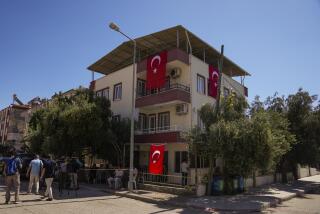Armenian genocide: ‘Multiply my dad’s story a million and a half times’
A giant wreath was placed by the Armenian genocide memorial plaque at the Glendale Community College on Thursday as a procession of a few hundred students and faculty watched.
Armine Hacopian, a member of the college’s board of trustees, was one of the first to speak Thursday and shared the story of her father, who was a young boy during the genocide and survived it.
FULL COVERAGE: 100th anniversary of Armenian genocide
Hacopian’s father, Sako Shadakhouni Gordian, was playing with his brother when they were separated and hidden in different places as their home was raided.
Her dad survived, but always assumed his brother had died, but he found out about 50 or 60 years later while living in Iran and working as a photographer that his brother was still alive in Armenia.
Despite finding this out, they never met again.
“Multiply my dad’s story a million and a half times,” Hacopian said. “Every [Armenian] family has a similar story, every family has lost someone.”
The board’s president, Vahe Paroomian, was the keynote speaker during the event and went over many historical aspects and quotes regarding the genocide, listing the 10 steps of what constitutes such a tragedy.
The final stage, he said, is denial and it’s a stage that’s been ongoing for the past century because of the Turkish government’s refusal to acknowledge the genocide.
“The continued denial of the genocide by the republic of Turkey actually means the Armenian Genocide never ended and that genocide continues today,” he said.
At this point, however, it will take more than recognition, Paroomian said.
“Recognition by the government of Turkey will finally end the genocide, but the healing process will not and could not begin without reparations,” he said.
Before he spoke, history and political science professor Levon Marashlian showed a video clip from 1991, when the genocide plaque was first installed on campus.
The clip showed past City Council members Eileen Givens and Larry Zarian speaking at the unveiling.
The plaque has since moved three times around campus, mainly due to renovations, Marashlian said.
“The history of this genocide plaque sort of parallels the history of the Armenian people,” he said.
Arin Mikailian reports for Times Community News.
More to Read
Sign up for Essential California
The most important California stories and recommendations in your inbox every morning.
You may occasionally receive promotional content from the Los Angeles Times.











